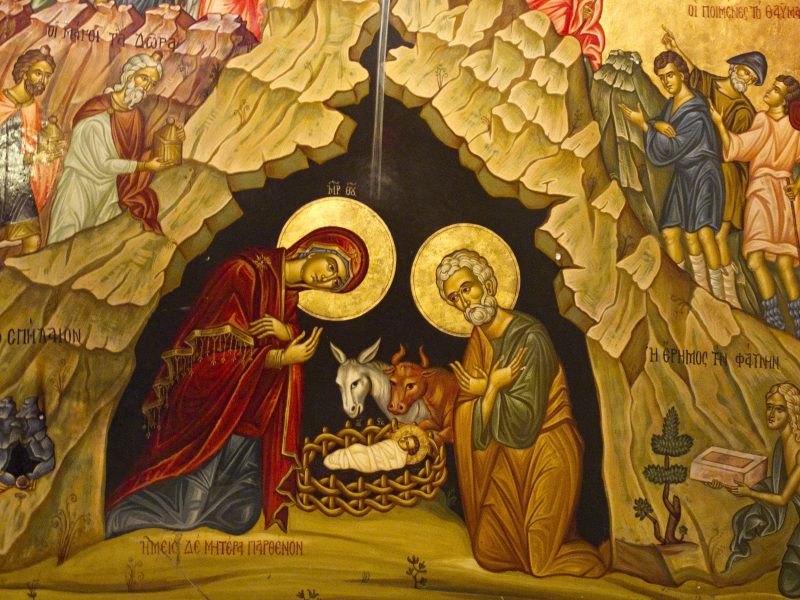
Who Fills All Things
The Solemnity of the Ascension. Fr Colin Carr ponders the meaning of Christ’s heavenly exaltation.
One of the features of some resurrection stories and the story of the Ascension in Acts is men in white telling people they’re looking in the wrong place or the wrong direction. ‘Men of Galilee, why are you standing staring into the sky?’ – as though they might catch a glimpse of his getting smaller and smaller as he continues on a particular trajectory upwards. But the cloud is always a sign of God’s enveloping presence in which time and space are no longer minutes and metres.
Jesus has gone away, not to another place which a clever computer could in principle discover, but to the no-place and not-time which are the source of our minutes and metres, which makes our minutes and metres meaningful and mysterious, if you’ll excuse the alliteration.
So Ascension isn’t so much a spatial term as a qualitative one: it’s the Exaltation of Jesus ‘to God’s right hand’ – another spatial term which we have to use because we are creatures of space and time but which we know means far more than the picture it conjures up. (Don’t stand staring to see if you can spot a throne).
The Ephesians passage puts it in a way I find very helpful: ‘The one who went down (Down? Yes, we’ll come to that in a moment) is the same as the one who went up above all the heavens (but surely the heavens are The Highest – you can’t get higher than that? Well, Jesus did) so that he might fill everything.’ The same: there are not two beings, Jesus of Nazareth who went about Galilee and went to Jerusalem and died, and the Cosmic Christ who is above the heavens and is filling everything. That is what I mean by the Ascension being multi-directional. Well, that’s part of what I mean, because we need to look at this word ‘Down’ which occurs in the Ephesians passage.
Just before the passage we’ve been looking at, we read: ‘What does “went up” mean other than that he went down to the lower parts of the earth?’ What does that mean? Some people will immediately think of the Harrowing of Hell, and that may be part of it. But we may think in terms of low life (Jesus was accused of mixing with low life), and the depths – of depression or of failure, or hitting rock bottom, or being sent down (to prison) and all the things we would rather not think about. And Jesus has been there and is the same Jesus as the one who is exalted to fill everything, so no desperate, humiliating, or demeaning situation is outside of his ken, outside of his sympathy, outside of his triumph and exaltation. Feeling forsaken is a Christ-like feeling, and is not unknown to the Cosmic Christ who is above the heavens and fills all things.
I once preached at the funeral of a great friend of the Dominicans whose life had rather fallen to pieces at the end, and I was initially minded not to say anything about the ‘failures’ in his life. But on my way to the funeral – I was travelling by train across the North of England – I changed my sermon to include a reference to his not coping, because that was the experience of Jesus too (‘My God, my God, why ….’) and we don’t need to be fazed by the depths.
Praise to the Holiest in the height,
And in the depth be praise.
The Ascension is the crowning of the One who went into the depth; there is now no situation which is beyond the reach of the one who fills everything, and no person has sunk too low.
But more than all this, the Ascended One is at work in the Church, building up his own body: the Church in its ministries and in its unity is not simply proclaiming Christ, not simply imitating him – both of which are excellent things to be doing; it is sharing the life of the One who fills everything, in the double sense that it is living from his life through the Spirit, and welcoming others into that life; and so it goes on. Alleluia!
Readings: Acts 1:1-11 | Ephesians 4:1-13 | Mark 16:15-20
Image: Christ Enthroned: from the ceiling of Ely Cathedral painted by Thomas Gambier Parry in 1865, photographed by Fr Lawrence Lew OP



Frances Flatman
Liked
Father Michael Tate
I loved the no place no time theme. And it is beautifully composed as a sermon and not a lecture.
Michael
Thank you Colin – I never understood that line from Ephesians about the One who went up being the same as the One who went down- until reading your homily above.
Wow!
That is such a powerful breaking open for me.
God Bless You.